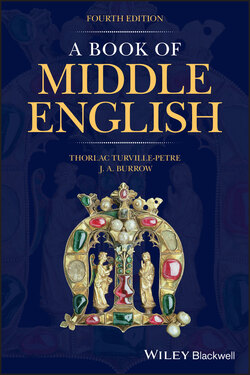Читать книгу A Book of Middle English - J. A. Burrow - Страница 64
5.4.6 Relative Pronouns
ОглавлениеOver most of the Middle English period the most common relative pronoun corresponding to Modern English ‘who’, ‘which’ and ‘that’ is þat, used to refer to both personal and non‐personal antecedents, singular and plural: King Pluto and … King Juno … þat sumtime were as godes yhold, ‘who were once regarded as gods’, 5/43–5.
In early texts þe and þa are also used. In Laʒamon’s Brut, þe tends to be used with reference to masculine singular antecedents, þa for plural and for feminine singular, and þat for inanimate or neuter singular: thus Hengest þe cnihten wes faʒerest, ‘Hengest who was most gracious of knights’, 3/168. Yet the distinction in usage is not clear‐cut; here þa is used to refer to a neuter noun: his spere … þa Ron wes ihaten, ‘his spear that was named Ron’, 3/24.
þat is regularly used as a relative without the antecedent noun or pronoun, when it is equivalent to modern ‘what’ or ‘he who’, ‘anyone who’ etc.: now þat London is nevenyd, ‘what is now called London’, 11/25; betere therby þat byleve the fynden, ‘benefit thereby those who provide you with food’, 7a/21; þe devel have þat reche, ‘the devil take anyone who bothers’, 7b/127. In the following example the reader may easily misinterpret þat, wrongly supposing that it is þe water that wants to escape: scopen out þe scaþel water þat fayn scape wolde, ‘those who were keen to escape scooped out the dangerous water’, 8/155.
In order to indicate case, þat is combined with a personal pronoun, so þat … his means ‘whose’: þat merkid is in oure martilage his mynde, ‘whose memory is set down in our burial‐register’, 11/154. þat may refer back to a genitive pronoun rather than its noun, in this instance his rather than bour: þer watz bylded his bour þat wyl no bale suffer, ‘there was built the bower of the man who will suffer no harm’, 8/276.
In later Middle English which becomes increasingly common as an alternative to þat, for both persons and things: sche which kepþ þe blinde whel, 13/92. Which, ‘who’, is accompanied by þat as a conjunction in This abbot, which þat, 18b/190. The combination þe which was favoured by some writers: o principal worching miʒt þe whiche is clepid a knowable miʒt, 6/63–4.
There is sometimes no relative pronoun at all. The ‘zero’ relative pronoun is used in Modern English as the object of the clause: ‘the woman (whom) I saw’. In Middle English it is also used when it is subject: fro bale has broʒt us, ‘who has brought us from anguish’, 11/340; for hym þe boght, ‘for him who redeemed you’, 15/101.
